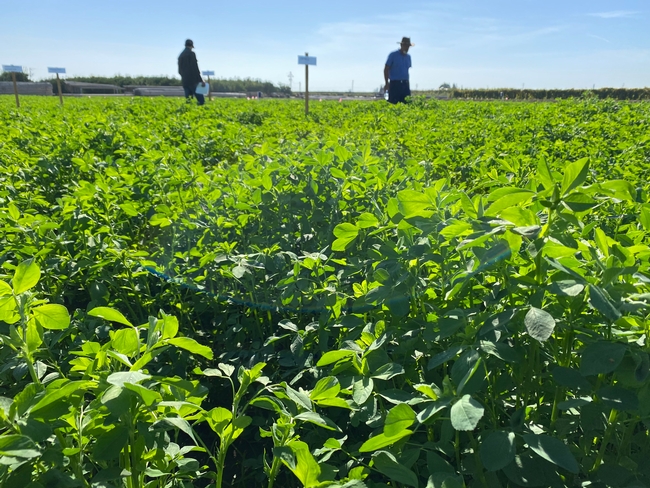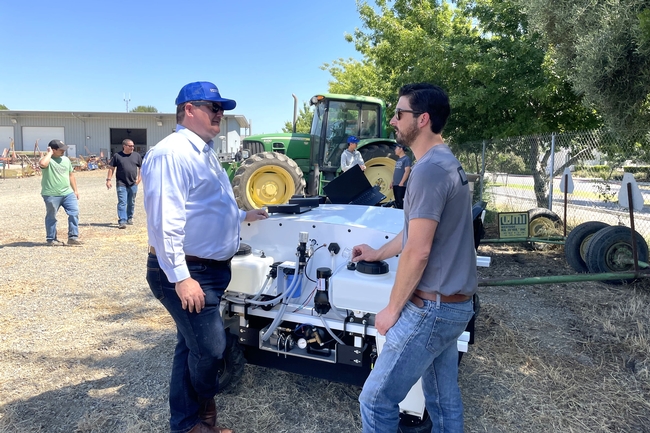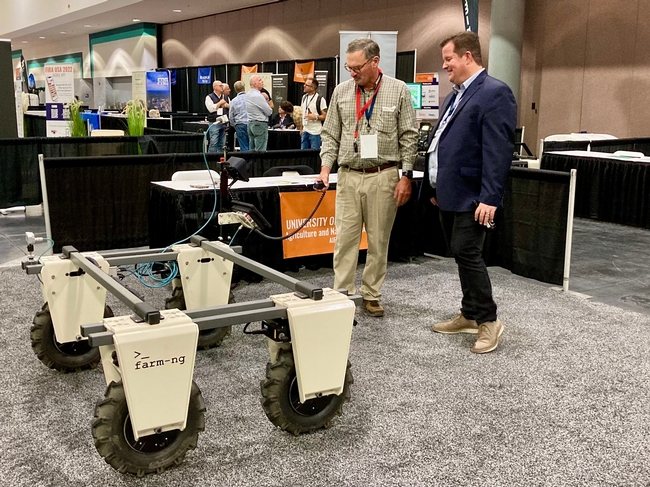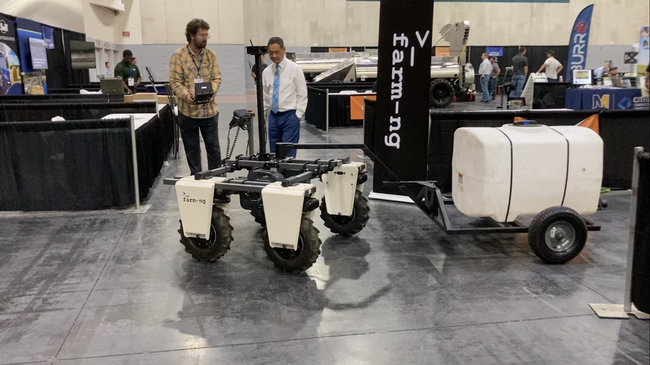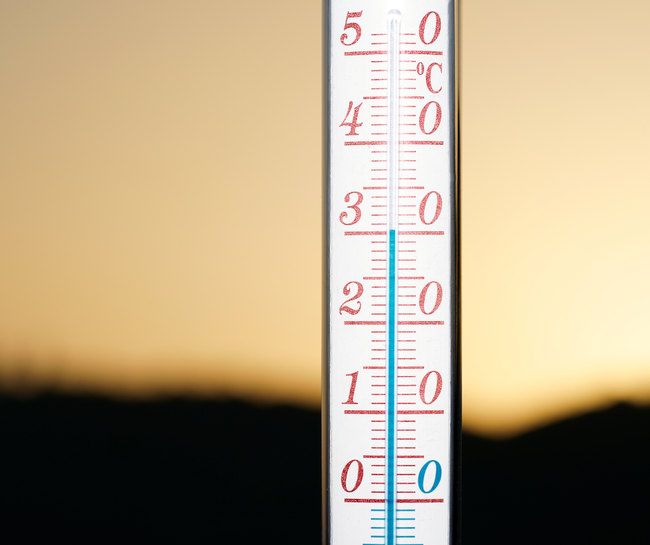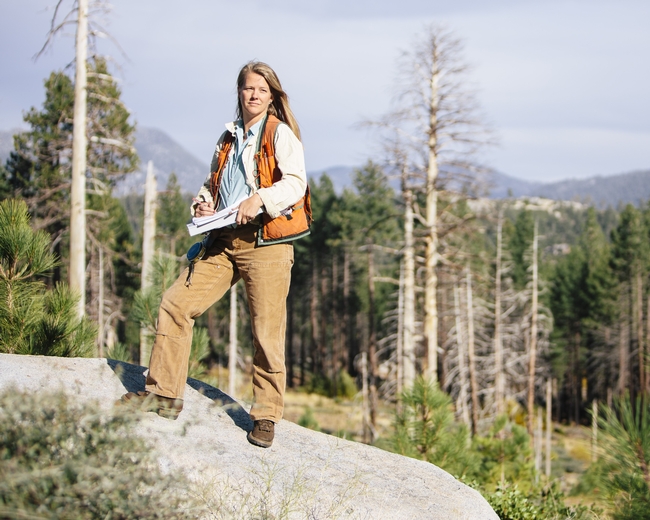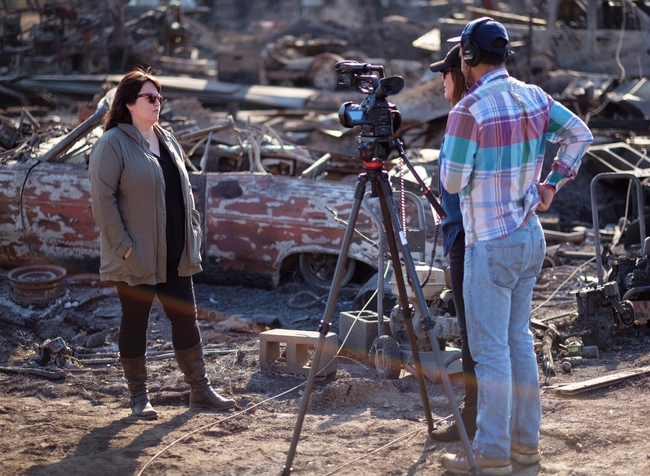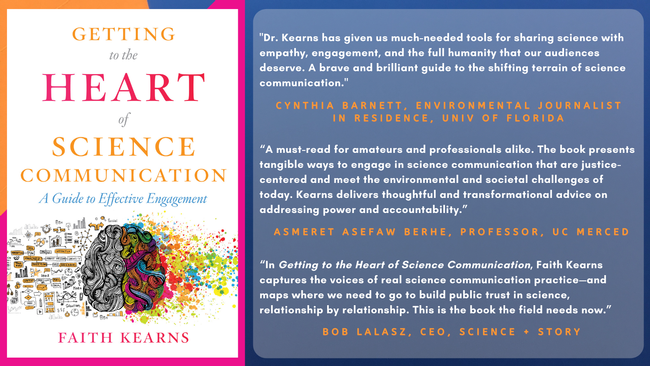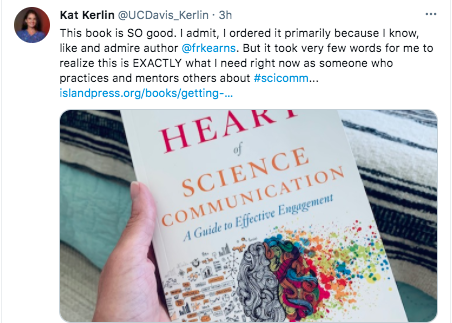Posts Tagged: climate
$1.7M granted for climate-smart planning led by UC ANR scientists
In California, natural and working lands make up 95 million acres of the state and play a vital role in building resilience to the impacts of climate change. University of California Agriculture and Natural Resources was awarded $1.7 million for the California Next Generation and Equitable Climate Action Plan, as part of the state's Natural and Working Lands Climate Smart Strategy and California's 30x30 Initiative, an effort to conserve 30% of the state's lands and coastal waters by 2030.
Natural and working lands include both unmanaged and managed areas actively used for agriculture, forestry or production purposes.
Chandra Richards, UC Cooperative Extension agricultural land acquisitions academic coordinator for Southern California, and Cristina Murillo-Barrick, UCCE's Black, Indigenous and People of Color community development advisor for the Bay Area, are leading the California Next Generation and Equitable Climate Action Plan project.
To build capacity and technical assistance for climate-smart action planning, Richards and Murillo-Barrick will use the Climate Smart Land Management Program funding, awarded through the California Department of Conservation, to focus on two of the most pressing climate action issues: equitable land access and land management diversification.
According to the 2022 U.S. Department of Agriculture census, demographic data indicates that California agricultural land ownership and production is concentrated within an aging and mostly White demographic. However, research suggests diverse management practices promote healthy landscapes. This has been shown to benefit the environment, human health and climate resilience in multiple ways.
For this reason, this project centers on “historically underrepresented communities,” a term that includes California Native American Tribes, communities of color, landless farmers, immigrant and non-English speaking communities and other agency-designated minority groups (racial, ethnic and non-male groups, socially disadvantaged farmers and ranchers, and California designated severely disadvantaged communities).
Focusing on Southern California, UC Cooperative Extension scientists will identify barriers to land access, management and opportunities to increase land manager diversity. They also will engage historically underrepresented communities in coalition building, capacity assessment and climate action planning.
Within the last few decades, Californians have faced increased ecosystem stressors and decreasing diversity of natural systems. This pattern continues to damage already-vulnerable communities (disproportionately historically underrepresented communities), while also worsening and intensifying climate impacts, including drought, wildfire, flooding and disease. Overcoming these kinds of systemic and structural challenges will require the next generation of land managers to reflect California equitably, while preparing them to take on climate resilience. The project will determine clear solutions and plans that enable long-term, strategic land use and protection.
To do this work, UCCE is collaborating with the Community Alliance with Family Farms (CAFF), California Association of Resource Conservation Districts (CARCD) and the California Bountiful Foundation, all of whom serve as subgrantees and will deepen connections with communities.
Organizations like CARCD have long served as “boots on the ground” personnel and have close relationships with landowners and land managers. “RCDs have been hearing the land equity need for a long time and are actively collaborating with different partners to tackle this pressing issue,” said Qi Zhou, program manager of Justice, Equity, Diversity and Inclusion at CARCD and member of the Strategic Growth Council Land Equity Task Force.
“California RCDs are excited about this project because it will allow major California agriculture and conservation partners to collaboratively develop plans and implement projects centering on equity land access and land management diversification,” Zhou added.
Project lead Richards said $270,000 of the grant will be reserved for new partnerships with organizations in Southern California that have experience with, and strong ties to, historically underserved communities.
UC ANR is collaborating with the California Department of Food and Agriculture as well as California Climate and Agriculture Network (CalCAN), and World Be Well, a Southern California nonprofit.
Tawny Mata, CDFA's director of the Office of Environmental Farming and Innovation, described technical assistance providers as being grounded in their local agricultural communities and recognized their importance to partners in the success of CDFA's incentive programs.
“When we do succeed in reaching historically underserved farmers and ranchers with our grant programs, it is often with the thoughtful support and planning of a technical assistance provider,” Mata said. “I look forward to this project helping us refine our own technical assistance funding programs and bringing technical assistance providers together to network and share best practices for improving land access and promoting climate-smart agriculture.”
“The successes of this project will elevate the voices of historically underrepresented communities, strengthening efforts in these communities to support climate action,” said Richards. Additionally, the project will increase sharing of regional reports, needs assessments and community plans surrounding climate-smart management practices. Finally, it will boost technical assistance for these groups specifically.
To learn more about the Climate Smart Land Management Program and this year's awardees, visit:
The VINE announces call for startups to apply for field-trial support
Validation of Innovation Program provides supportive ecosystem for startups
The VINE, an initiative by the University of California Agriculture and Natural Resources, is now accepting applications for its VINE Validation of Innovation Program. The program aims to support innovation in the agri-tech sector, particularly in climate-resilient solutions for California food systems.
Made possible with support from a UC Climate Action grant, the program is inviting startups to apply, with a focus on providing comprehensive support for field trials – a critical stage for any agri-tech venture.
"Field trials are vital for validating new innovations in the agri-tech sector,” said Gabe Youtsey, chief innovation officer with UC ANR and founder of The VINE. “The VINE VIP aims to provide a supportive environment for carrying out these essential tests, bridging the gap between innovative concepts and real-world application."
Elif Ceylan, co-founder of OpenGate Partners and head of the VINE VIP, also stressed the importance of field trials.
"Field trials serve as a crucial phase where promising ideas either succeed or require adjustment,” Ceylan said. “We are committed to prioritizing this stage to ensure the effectiveness and relevance of emerging agri-tech solutions."
The VINE VIP offers more than field trials. It provides a supportive ecosystem for startups, including industry connections, access to a broad network of farmers and experts, comprehensive validation results and market entry support. The program is a unique accelerator that pairs startups with project partners in the agri-tech industry, facilitating Proof of Concept projects and commercialization trials for industry-defined challenges in California agriculture.
By connecting startups with farmers, academics and industry experts, the program aims to validate, advance, adopt and amplify innovative technologies, reducing technological risks and accelerating sales through its extensive industry network.
Startups interested in joining the VINE VIP can apply until Sept. 16, 2023. Detailed information about the program and the application process is available on The VINE's website at thevine.io/vip.
The VINE is an initiative of the University of California Agriculture and Natural Resources, dedicated to fostering agriculture, food, and biotech innovation in California. Our mission is to support industries and entrepreneurs while promoting technology innovation and commercialization for sustainable and equitable food systems. We connect entrepreneurs with public and private sector resources, encourage collaborations to address industry challenges, and promote regional capacity for global innovation as an economic opportunity.
UC ANR receives $1 million for VINE Climate Smart Agrifood Innovation Program
University of California Agriculture and Natural Resources (UC ANR) has been awarded a $1 million UC Climate Action Innovation & Entrepreneurship grant for its VINE Climate Smart Agrifood Innovation Program. The VINE, a UC ANR program advancing sustainable agriculture and food innovation, will use the grant to develop new technologies and techniques that help California farmers adapt to climate change.
"Expanded programming from The VINE will improve UC ANR's overall ability to serve our mission of improving the lives of all Californians," said Glenda Humiston, UC vice president for agriculture and natural resources.
California's agricultural sector is the largest in the United States, producing over 400 crops that account for 25% of the nation's food production and 40% of its fruits, vegetables and tree nuts.
However, climate change is expected to have a significant impact on the productivity and resilience of California's working landscapes. Higher temperatures and changing precipitation patterns are projected to increase water demand for crops and create a more limited growing season that will produce lower yields in some crops. Additionally, climate change may increase weed growth and insect damage, leading to higher uses of herbicides and pesticides.
“We are thrilled to receive the UC Climate Action Innovation & Entrepreneurship Award,” said Gabe Youtsey, UC ANR's chief innovation officer. “With this grant, we will be able to support even more entrepreneurs and innovators in developing climate-resilient solutions for California's agriculture and food systems."
"Our ultimate goal is to build a bioeconomy in California's food valleys that rivals Silicon Valley in size and importance to the future U.S. economy, while also addressing urgent climate crises and advancing equity for underserved populations," Youtsey said.
The VINE Climate Smart Agrifood Innovation Program is designed to identify, commercialize, and scale science and technology breakthroughs that make food production more sustainable. The VINE team has already supported entrepreneurs in the areas of controlled environment agriculture, precision agriculture, robotics, biologicals, climate-resilient crops, livestock health, and other topics that have direct or indirect mitigating effects on climate change.
The UC Climate Action grant will enable The VINE program to expand its support for startups and entrepreneurs developing climate-resilient solutions for California's food system. The program will include the creation of a VINE Climate Solutions Seed Fund, which will provide project support for testing, trialing and demonstrating agrifood technology products or services to support commercial expansion.
The VINE Navigator Service will be expanded to provide matchmaking, mentoring, talent identification, finance connections and technical assistance to entrepreneurs from UC campuses, across California, or startups around the globe that have climate solutions in the agrifood sector.
An example of this work is farm-ng, a farm robotics start-up based in Watsonville that The VINE has been advising. With the networking opportunities facilitated by The VINE, farm-ng was able to secure 20 new customers, generating an estimated $500,000 in revenue. The VINE's involvement also enabled farm-ng to establish a professional manufacturing facility and employ local talent from disadvantaged communities.
The award is part of a historic $185 million partnership between UC and the state of California to tackle the climate crisis, from developing new methods for carbon capture to creating innovative coping strategies for drought, wildfire and other impacts of a warming planet.
The VINE
The VINE program aims to create a next-generation agrifood technology bioeconomy in California's food valleys to promote sustainable economic growth, address climate crises, and advance equity for underserved regions and populations. The VINE team will work closely with local and regional partners to identify key industry-driven gaps and opportunities across the food system and provide critical support to startups and entrepreneurs developing new solutions for climate mitigation and adaptation.
For more information, please visit The VINE website: thevine.io.
Disaster resources available to prepare for heat, wildfire, power outages, quakes
September is National Preparedness Month, designated to encourage disaster and emergency readiness. To help Californians prepare for extreme heat, earthquakes, public safety power shutoffs and wildfire, University of California Cooperative Extension has created a disaster preparedness website organized for quick access to critical information.
The website https://ucanr.edu/Disaster contains fact sheets with tips for getting prepared.
“Unfortunately, with a warming climate, we are facing more and more extreme climate-related events such as heat waves, wildfires, power shutoffs and storms. All Californians need to step up their preparedness efforts to be ready to meet this more uncertain future,” said Susan Kocher, UC Cooperative Extension forestry advisor, who co-authored the disaster preparedness resources for the website.
Extreme heat
The fact sheet for extreme heat events offers suggestions for avoiding heat exposure, such as identifying nearby cooling centers and covering windows to keep heat out. It also suggests things to do during hot weather such as staying hydrated, taking cool showers and keeping pets indoors. It describes symptoms of heat-related illnesses, which can have serious health effects.
Public Safety Power Shutoff
During extreme weather events, electrical power in high fire-threat areas may be shut off to prevent sparking. This precaution is known as a Public Safety Power Shutoff. A PSPS is most likely to occur from May to November, when conditions are the hottest and driest.
UC Cooperative Extension recommends signing up to receive PSPS alerts from your energy company. Experts also advise making a plan for medications that need to be refrigerated or medical devices that require power. To prevent foodborne illness, they offer suggestions for ensuring food safety during and after a power outage.
Wildfire and smoke
Wildfire smoke can harm your health. During wildfires, UC Cooperative Extension recommends wearing an N95 outdoors to reduce smoke exposure and taking steps to prevent smoke from entering buildings. To reduce wildfire risk, the website describes methods of removing flammable vegetation around homes.
Earthquakes
UC Cooperative Extension offers safety tips for before, during and after an earthquake. Identifying the safest place in your home during an earthquake in advance is helpful. For example, doorways are not the safest place to be in modern homes. Experts recommend crawling under a sturdy desk or table, while avoiding areas next to windows, beneath ceiling fixtures or near large items that may fall during an earthquake.
The website also offers resources on drought, food safety after a fire, and wildfire preparedness and recovery.
In 2020 and 2021, Cooperative Extension researchers from around the country held listening sessions with community members who had experienced extreme weather events and other types of disasters to learn what had worked well, what had not, and how communities could be strengthened.
In response, these disaster resources were developed by Kocher, UC Davis undergraduate student Caydee Schweitzer, Tracy Schohr, UC Cooperative Extension livestock and natural resource advisor, and Vikram Koundinya, UC Cooperative Extension evaluation specialist. The group plans to add fact sheets on more disaster topics in the future.
This project was funded by a USDA National Institute of Food and Agriculture Renewable Resources Extension Act grant.
MEDIA CONTACT: Susan Kocher, UC Cooperative Extension forestry advisor, sdkocher@ucanr.edu
Communicating about climate crisis and other scientific issues requires more than facts
New book offers advice for discussing misconceptions and oversimplifications
Research can inform people to take appropriate action to solve problems, but effectively communicating is key. Faith Kearns, who works on emotional and contentious water-related issues such as climate change, drought and wildfire, has learned firsthand that the way scientists communicate can deeply affect people and communities.
Kearns, an academic coordinator for the California Institute for Water Resources at University of California Agriculture and Natural Resources, has written about what she has learned in 25 years of practice in a new book, Getting to the Heart of Science Communication: A Guide to Effective Engagement from Island Press. The book includes on-the-ground experiences of many science communicators, including those working in Cooperative Extension.
“The book offers an on-the-ground perspective on communicating emotional and contentious topics and is filled with concrete examples from practitioners, which is different from many science communication books written by journalists or researchers,” Kearns said. “It is centered around practical tools like relating, listening, working with conflict, and understanding trauma, all with an eye toward equity and justice.”
Among the many issues addressed in the book – ranging from food security to disasters – climate change is one of the biggest. Meteorologist and climate journalist Eric Holthaus notes in the foreword that giving people scientific facts isn't convincing many people that there is a climate crisis, much less solving the climate emergency. “This crisis is getting worse not because of a deficit of information, after all, but because of a deficit of action,” writes Holthaus.
Grist journalist Kate Yoder wrote, “For a long time, scientists have relied on a ‘deficit' model of communication. The idea is that if people are given enough facts and data about, say, climate change, then they'd accept the science— in a logical, rational way — and decide to take action. This idea isn't necessarily wrong, but it ignores the messiness of the world and the role that emotions play in guiding decisions.”
Kearns begins the book with a personal anecdote that changed the way she thought about science communication. After she and her colleagues gave a presentation on wildfire preparation to residents in Mendocino County, an emotional audience member explained to Kearns that he had labored to keep a recent wildfire from consuming his property and the way the researchers had presented their information without attention to the fact that a fire had just burned through the area had been re-traumatizing.
“Many communicators, including myself, have neglected other pieces of communicating that don't have to do with providing information,” Kearns said. “It's so important to know who you are in conversation with and what they've been through. Their history, communities, and personal experiences impact how they will receive scientific information. One of the most important skills you can have as a science communicator is to be able to listen well.”
Jonathan Wai reviewed Kearns' book in Science. He wrote: “The book offers a view from the front lines of science communication, profiling practitioners who explain their journeys and share stories of relationship building and community engagement. Framing herself as a scientist turned science communicator, Kearns describe her vision for the future of the field, one in which relational communication is fundamental.”
Kearns acknowledges in the preface that a single book cannot be all things to all people. “My hope is that I can fairly treat the argument that emotion, conflict, and power struggles are already present in science communication and engagement work and that ignoring them is counterproductive,” she wrote.
Getting to the Heart of Science Communication is written for science communicators and scientists working at research institutions, government agencies, consulting firms or nonprofit organizations. In addition, it will be of interest to those working with scientists including journalists and decision-makers. People interested in science will also find much to consider in this updated view of the science communication landscape.
The 280-page paperback is published by Island Press and can be ordered for $30 (use code HEART for a publisher discount) at https://islandpress.org/books/getting-heart-science-communication and wherever books are sold.
For more about science communication, see Kearns' blog at https://faithkearns.substack.com.

